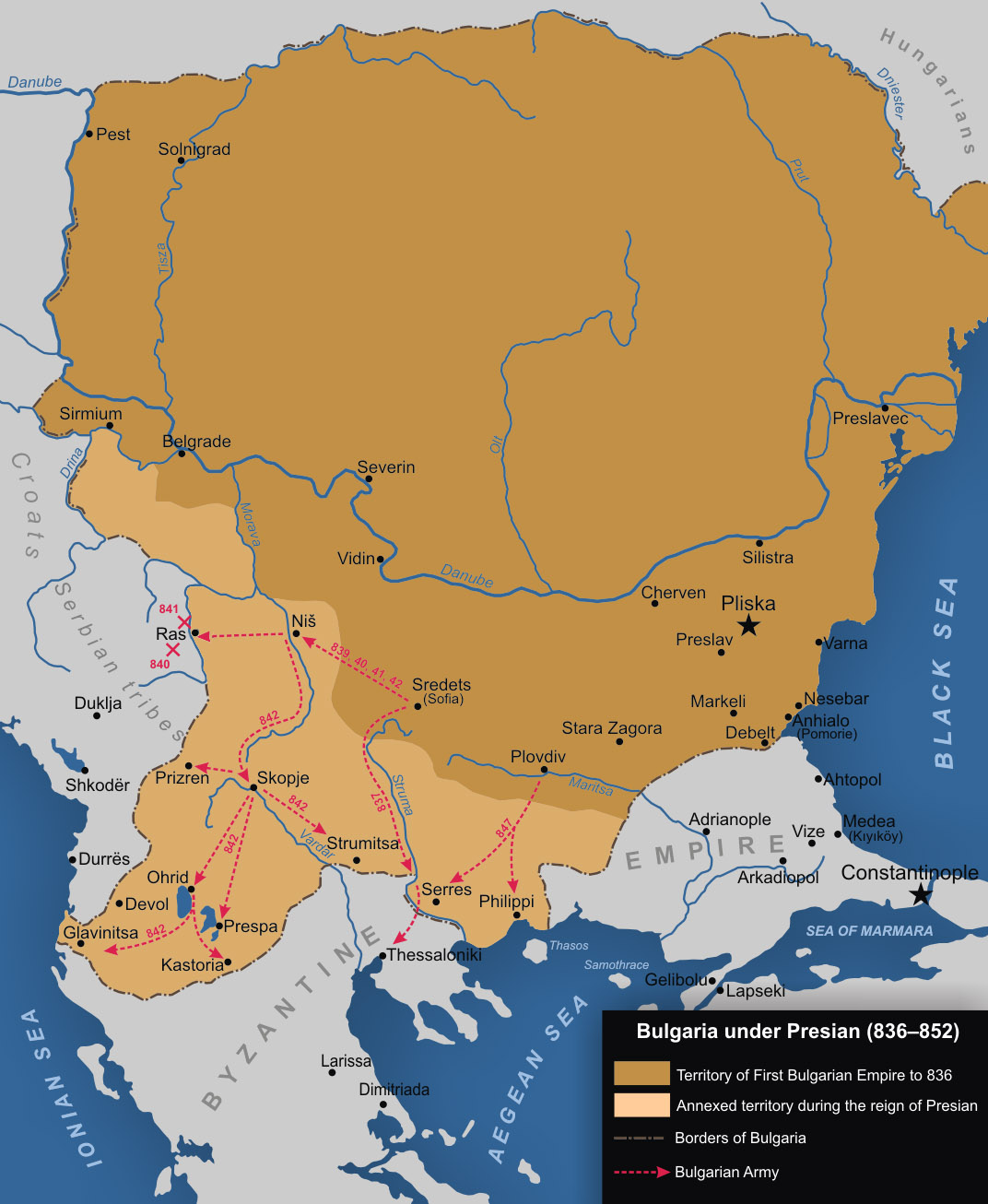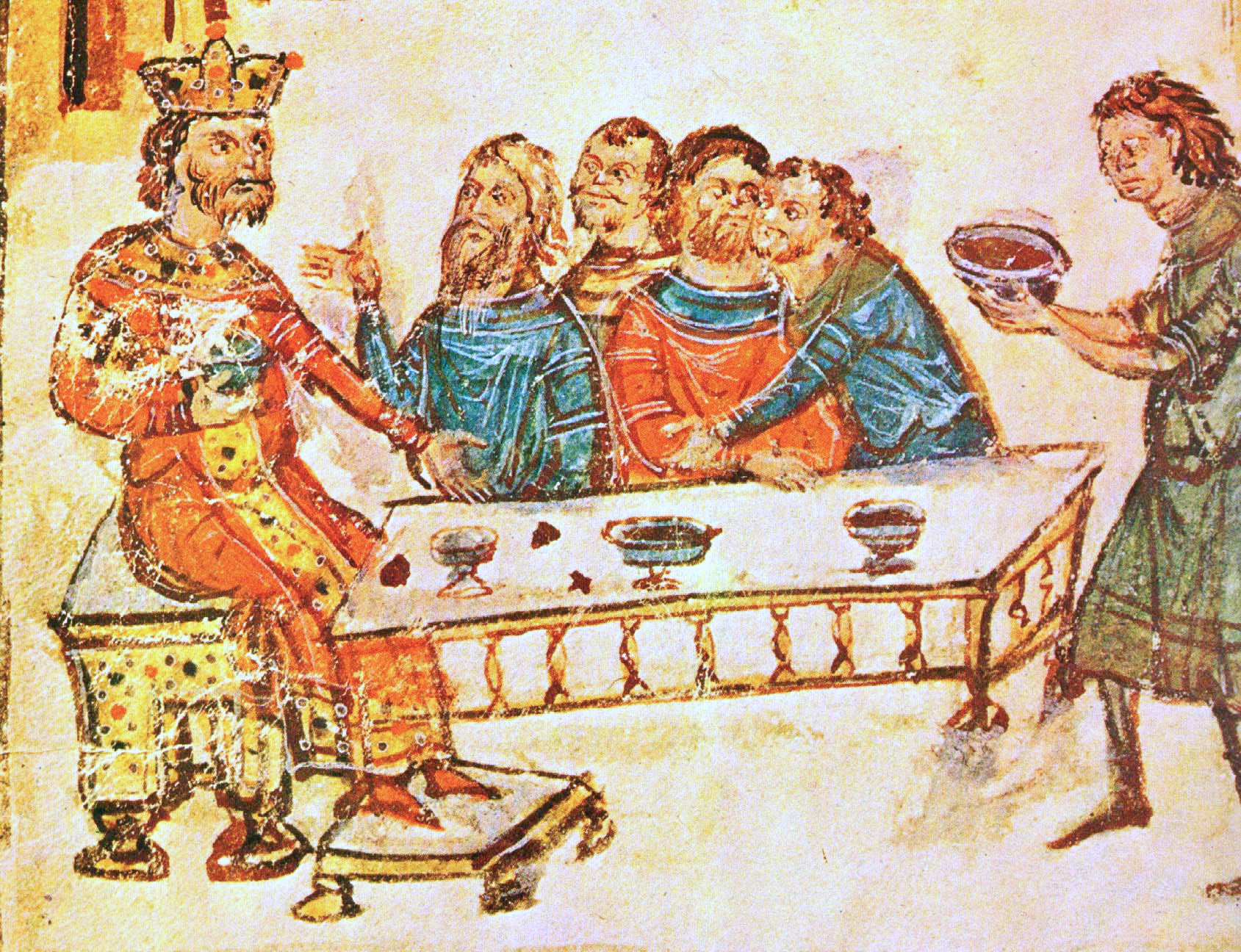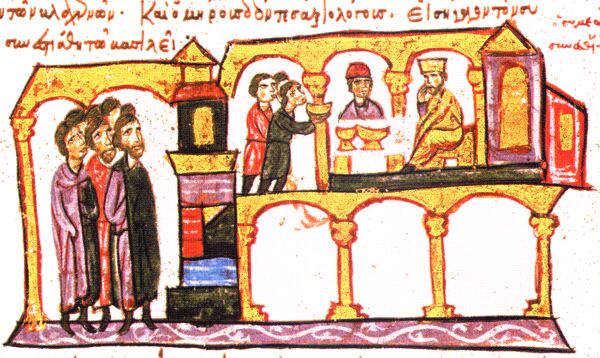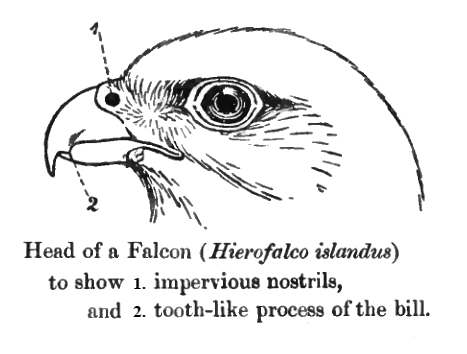|
Bulgar–Serb War (853)
The Bulgarian-Serbian War of 853 was fought between the First Bulgarian Empire and the Serbian Principality. It was the second conflict of the medieval Bulgarian–Serbian Wars. Prelude and the War After the death of Prince Vlastimir of Serbia in 850, his state was divided between his sons. Vlastimir and Presian, Boris' father, had fought each other in the Bulgar-Serb War (839–42), which resulted in a Serbian victory. Boris sought to avenge that defeat, an in 853 or 854, the Bulgar army led by Vladimir-Rasate, the son of Boris I, invaded Serbia, with the aim to replace the Byzantine overlordship on the Serbs. The Serbian army was led by Mutimir and his two brothers, who defeated the Bulgars, capturing Vladimir and 12 boyars. Boris I and Mutimir agreed on peace (and perhaps an alliance), and Mutimir sent his sons Pribislav and Stefan to the border to escort the prisoners, where they exchanged items as a sign of peace. Boris himself gave them "rich gifts", while he was ... [...More Info...] [...Related Items...] OR: [Wikipedia] [Google] [Baidu] |
Bulgarian–Serbian Wars (medieval)
The Bulgarian–Serbian wars were a series of conflicts between the Bulgarian Empire and medieval Serbian states between the 9th and 14th centuries in the central Balkans. Before the 12th century, the Serbian states were dependent upon and strongly influenced by the dominant Balkan powers, the Bulgarian and Byzantine Empires. The rulers of both those countries sought to control Serb princes to use them as allies in the Byzantine-Bulgarian Wars. The first war between Bulgarians and Serbs occurred during the reign of Presian between 839 and 842, precipitated by Byzantine diplomacy. Later after series of campaigns the Bulgarian Emperor Simeon I conquered and destroyed the Serb state in 924. The Bulgarian Emperor Peter I granted formal independence to Serbia in 931 and appointed his protégé Časlav Klonimirović as its ruler. The most powerful Serbian state of the time, that of Duklja, was again subjugated by Emperor Samuil in 998. In the 13th century Stefan Dragutin and h ... [...More Info...] [...Related Items...] OR: [Wikipedia] [Google] [Baidu] |
Stefan Mutimirović
Stefan Mutimirović (, ) was a 9th-century Serbian royal member of the ruling dynasty, the Vlastimirović. He was the younger son of Mutimir of the ruling Serbian dynasty, the Vlastimirovići. His father had with his brothers Strojimir and Gojnik, defeated the Bulgar Army sent by Tsar Boris, led by his son Vladimir. They were captured with 12 boyar A boyar or bolyar was a member of the highest rank of the feudal nobility in many Eastern European states, including Bulgaria, Kievan Rus' (and later Russia), Moldavia and Wallachia (and later Romania), Lithuania and among Baltic Germans. C ...s, but were soon freed in exchange for good relations between the peoples. Peace was agreed upon and Stefan and his older brother, Pribislav, escorted the prisoners towards the border at Ras. There, Boris gave them rich gifts and received 2 slaves, 2 falcons, two dogs, and 80 furs from Mutimir. References Sources * * * *Ferjančić, B. 1997, "Basile I et la restauration du pou ... [...More Info...] [...Related Items...] OR: [Wikipedia] [Google] [Baidu] |
Byzantine–Bulgarian Wars
The Byzantine–Bulgarian wars were a series of conflicts fought between the Byzantine Empire and Bulgaria which began after the Bulgars conquered parts of the Balkan peninsula after 680 AD. The Byzantine and First Bulgarian Empire continued to clash over the next century with variable success, until the Bulgarians, led by Krum of Bulgaria, Krum, inflicted a series of crushing defeats on the Byzantines. After Krum died in 814, his son Omurtag negotiated a thirty-year peace treaty. Simeon I of Bulgaria, Simeon I had multiple successful campaigns against the Byzantines during his rule from 893 to 927. His son Peter I of Bulgaria, Peter I negotiated another long-lasting peace treaty. His rule was followed by a period of decline of the Bulgarian state. In 971 John I Tzimiskes, the Byzantine emperor, subjugated much of the weakening Bulgarian Empire by defeating Boris II of Bulgaria, Boris II and capturing Preslav, the Bulgarian capital. Samuel of Bulgaria, Samuel managed to stabiliz ... [...More Info...] [...Related Items...] OR: [Wikipedia] [Google] [Baidu] |
850s Conflicts
85 may refer to: * 85 (number) * One of the years 85 BC, AD 85, 1985, 2085 * 85 Io 85 Io is a carbonaceous asteroid in the central region of the asteroid belt, approximately 170 kilometers in diameter. It is an identified Eunomian interloper. Discovery and naming It was discovered by C. H. F. Peters on 19 September 186 ..., a main-belt asteroid See also * * List of highways numbered {{Numberdis ... [...More Info...] [...Related Items...] OR: [Wikipedia] [Google] [Baidu] |
Wars Involving The First Bulgarian Empire
War is an armed conflict between the armed forces of State (polity), states, or between governmental forces and armed groups that are organized under a certain command structure and have the capacity to sustain military operations, or between such organized groups. It is generally characterized by widespread violence, destruction, and mortality, using Regular army, regular or Irregular military, irregular Military, military forces. ''Warfare'' refers to the common activities and characteristics of types of war, or of wars in general. Total war is warfare that is not restricted to purely legitimate military targets, and can result in massive Civilian casualty, civilian or other non-combatant suffering and Casualty (person), casualties. Etymology The English word ''war'' derives from the 11th-century Old English words and , from Old French ( as in modern French), in turn from the Frankish language, Frankish , ultimately deriving from the Proto-Germanic language, Proto-Ge ... [...More Info...] [...Related Items...] OR: [Wikipedia] [Google] [Baidu] |
Wars Involving Medieval Serbian States
War is an armed conflict between the armed forces of states, or between governmental forces and armed groups that are organized under a certain command structure and have the capacity to sustain military operations, or between such organized groups. It is generally characterized by widespread violence, destruction, and mortality, using regular or irregular military forces. ''Warfare'' refers to the common activities and characteristics of types of war, or of wars in general. Total war is warfare that is not restricted to purely legitimate military targets, and can result in massive civilian or other non-combatant suffering and casualties. Etymology The English word ''war'' derives from the 11th-century Old English words and , from Old French ( as in modern French), in turn from the Frankish , ultimately deriving from the Proto-Germanic language">Proto-Germanic . The word is related to the Old Saxon , Old High German , and the modern German , meaning . History Anthro ... [...More Info...] [...Related Items...] OR: [Wikipedia] [Google] [Baidu] |
9th Century In Serbia
Events from the 9th century in, or regarding, Historic Serbia or Serbs. Monarchs The following, of the Vlastimirović dynasty, ruled Serbia: * Prince Višeslav (fl. 768–814) * Prince Radoslav (ca. 814–822) * Prince Prosigoj (ca. 822–836) * Prince Vlastimir (ca. 836–850) * Prince Mutimir (ca. 850–891) ** Prince Strojimir (co-ruler ca. 850–?) ** Prince Gojnik (co-ruler ca. 850–?) * Prince Pribislav (891–892) * Prince Petar (892–917) Events * 805 ** Bulgar Khan Krum conquers Braničevo (Braničevci), the Timok Valley (Timočani) and the Obotrites, banishing the tribal chiefs and replacing them with administrators appointed by the central government. * around 814 ** Višeslav is succeeded by his son Radoslav. * 818 ** Braničevci and Timočani, together with other tribes of the frontier, revolted and seceded from Omurtag's Bulgaria because of an administrative reform that deprived them of much of their local authority. They left the association (socie ... [...More Info...] [...Related Items...] OR: [Wikipedia] [Google] [Baidu] |
Medieval Serbian Army
Serbia in the Middle Ages had an army that was well known for its strength and was among the strongest in the Balkans prior to the Ottoman conquest of Europe. Prior to the 14th century, the army consisted of European-style noble cavalry armed with bow and arrow, bows and lances (replaced with crossbows in the 14th century) and infantry armed with spears, javelins and bows. With the economic growth from mining, mercenary knights from Western Europe were recruited to finalize and increase the effectiveness of the army, especially throughout 14th century. History Early Middle Ages Between 839 and 842 the Bulgar Khan Presian I of Bulgaria, Presian invaded inland parts of the Serbian territory, the two having lived peacefully sharing a common frontier up until that point. The cause for the invasion is unclear. It led to a war that lasted three years, in which the Bulgars were decisively defeated. In the mid 850s the Bulgarians under Boris I of Bulgaria, Boris I made another unsucce ... [...More Info...] [...Related Items...] OR: [Wikipedia] [Google] [Baidu] |
Medieval Bulgarian Army
The medieval Bulgarian army was the primary military body of the First and the Second Bulgarian Empires, and some Puppet states of the former, like the Despotate of Dobruja. During the first decades after the foundation of the country, the army consisted of a Bulgar cavalry and a Slavic infantry. The core of the Bulgarian army was the heavy cavalry, which consisted of ca. 12,000 heavily armed riders. At its height in the 9th and 10th centuries, it was one of the most formidable military forces in Europe and was feared by its enemies. There are several documented cases of Byzantine commanders abandoning an invasion because of a reluctance to confront the Bulgarian army on its home territory. The army was intrinsically linked to the very existence of the Bulgarian state. Its success under Tsar Simeon I the Great marked the creation of a wide-ranging empire, and its defeat in a prolonged war of attrition in the early 11th century meant the end of Bulgarian independence. When the ... [...More Info...] [...Related Items...] OR: [Wikipedia] [Google] [Baidu] |
Petar Of Serbia
Petar Gojniković or Peter of Serbia ( sr-cyr, Петар Гојниковић, ; ca. 870 – 917) was List of Serbian monarchs, Prince of the Serbs from 892 to 917. He ruled and expanded the Principality of Serbia (early medieval), First Serbian Principality and won several wars against other family members that sought the crown. He was the first Serbian monarch with a Christian (non-Slavic) name. Petar was the son of Gojnik, the youngest son of Vlastimir (r. 831–851) of House of Vlastimirović, the first Serbian dynasty (ruling since the early 7th century). Early life Petar was born between 870 and 874, as the son of Prince Gojnik, the youngest son of dynastic founding father Vlastimir of Serbia, Vlastimir. His Byzantine Christian name, in relation to the previous generation of pagan names, shows the spread of Christianization among the Serbs.''The entry of the Slavs into Christendom''p. 209/ref> At the time of his birth, Serbia was ruled as an oligarchy consisting o ... [...More Info...] [...Related Items...] OR: [Wikipedia] [Google] [Baidu] |
Falcon
Falcons () are birds of prey in the genus ''Falco'', which includes about 40 species. Some small species of falcons with long, narrow wings are called hobbies, and some that hover while hunting are called kestrels. Falcons are widely distributed on all continents of the world except Antarctica, though closely related raptors did occur there in the Eocene. Adult falcons have thin, tapered wings, which enable them to fly at high speed and change direction rapidly. Fledgling falcons, in their first year of flying, have longer flight feathers, which make their configuration more like that of a general-purpose bird such as a broadwing. This makes flying easier while still learning the aerial skills required to be effective hunters like the adults. The falcons are the largest genus in the Falconinae subfamily of Falconidae, which also includes two other subfamilies comprising caracaras and a few other species of "falcons". All these birds kill prey with their beaks, using a ... [...More Info...] [...Related Items...] OR: [Wikipedia] [Google] [Baidu] |





